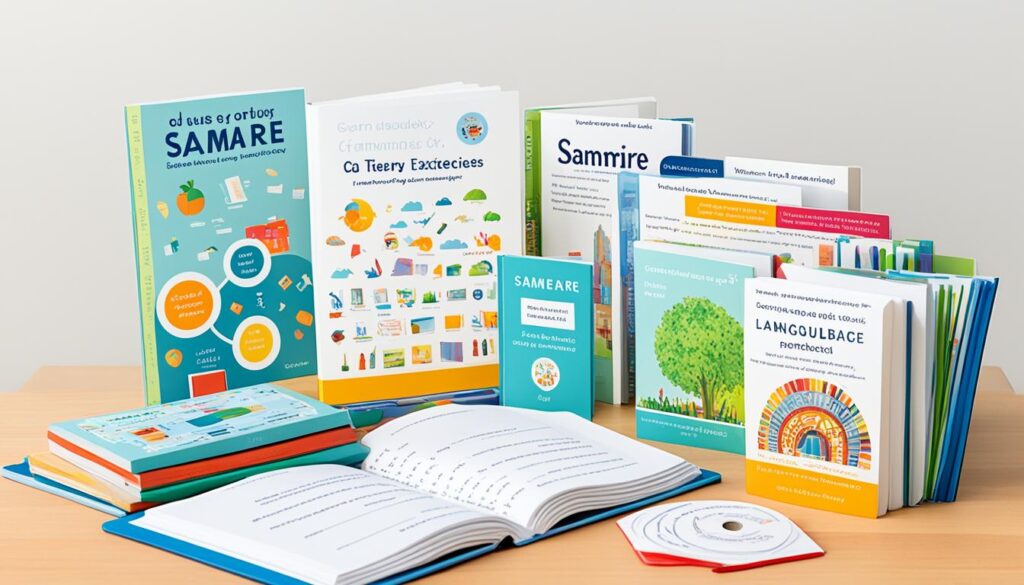Did you know that the Samre language, a nearly extinct Pearic language, is primarily spoken in Thailand with only a handful of speakers left worldwide? According to a 1998 survey, there are estimated to be only 20-30 speakers of Samre in Nonsi Subdistrict, Bo Rai District, Trat Province, Thailand, with a total estimated number of 200 people who can speak the language. The Samre language, belonging to the Austroasiatic language family, is known for its unique phonological features and is at risk of being lost forever.
Despite its endangered status, efforts have been made to preserve and document the Samre language, recognizing its cultural significance. In this article, we will explore the history and cultural importance of the Samre language, delve into its phonology, discuss the challenges of language preservation, and highlight the resources available for learning and preserving this beautiful dialect.
The History and Cultural Significance of Samre Language
The Samre language holds a significant place in the history and cultural fabric of Thailand. Belonging to the Pearic language group, which is part of the larger Austroasiatic language family, Samre is a unique language that has been preserved by its speakers for generations. This preservation effort has contributed to the rich cultural diversity of Thailand and showcases the resilience of the Samre-speaking communities.
The history of the Samre language is interwoven with influences from the late Middle Khmer period, as well as Thai language. These influences have shaped and enriched the phonological aspects of Samre, giving it a distinct character. The language has been used as a means of preserving cultural heritage and maintaining a sense of identity among the Samre-speaking population.
The cultural significance of the Samre language goes beyond its linguistic aspects. It serves as a vessel for the transmission of cultural practices, folklore, traditional music, and dance. The Samre-speaking community has maintained these cultural practices, making the language an integral part of their identity and heritage.
“The Samre language is not just a means of communication; it represents our history, our customs, and our connection to the land we call home.” – A Samre community member
Efforts are being made to promote the preservation and revitalization of the Samre language. Organizations and linguists recognize the importance of safeguarding this unique dialect and its cultural values. These endeavors aim to ensure that future generations have the opportunity to learn, speak, and cherish the Samre language and its cultural significance.
Comparison of Samre Language and Thai Language
| Aspect | Samre Language | Thai Language |
|---|---|---|
| Vocabulary | Distinct Samre vocabulary | Wider range of vocabulary |
| Phonology | Influenced by Middle Khmer, unique phonological features | Tonal language, influenced by Khmer |
| Writing System | Based on Khmer script, adapted for Samre | Thai script |
| Cultural Significance | An important part of Samre cultural heritage | Language of the majority in Thailand |
The comparison between the Samre and Thai languages highlights key distinctions and shared influences. While the Thai language enjoys a wider range of vocabulary and has become the language of the majority in Thailand, the Samre language retains its unique vocabulary and phonological aspects influenced by Middle Khmer. Both languages play a significant role in the cultural landscape of Thailand, representing diversity and linguistic heritage.
Phonology of the Samre Language
The Samre language showcases a complex and distinctive phonological system that contributes to its uniqueness within the Austroasiatic language family. Let’s explore the consonants, vowels, and phonemic inventory of the Samre language.
Samre Consonants
The Samre language features a total of 21 consonant phonemes. These include voiced and voiceless stops, nasals, fricatives, and approximants. The consonant inventory of Samre provides a foundation for the language’s distinctive sound patterns and articulation.
Samre Vowels
Samre has a vowel system composed of nine distinct vowel qualities. These vowels can be either short or long, contributing to the rhythmic patterns and cadence of the language. Additionally, diphthongs are present, enhancing the melodic and expressive nature of Samre speech.
Samre Phonemic Inventory
The phonemic inventory of the Samre language is a comprehensive collection of the distinct sounds used in the language. As part of this inventory, the consonants and vowels work together to form meaningful words and expressions. The inclusion of unique consonant allophones, such as [ɣ] and [ɹ], adds depth and complexity to Samre pronunciation.
To better understand the phonological aspects of the Samre language, refer to the phonemic chart below:

The Samre language’s phonological features, including its consonant and vowel systems, as well as its extensive phonemic inventory, contribute to its distinctiveness among Austroasiatic languages. These linguistic elements shape the sound and character of the Samre language, enriching the cultural heritage of its speakers.
Status and Challenges of Samre Language Preservation
The Samre language is facing a critical situation, with only a small number of speakers remaining. Once spoken in Cambodia, the language is now primarily spoken by a small community residing in Trat Province, Thailand. In response to the endangered status of the Samre language, various efforts have been made to document and preserve it, including the development of a Samre language dictionary and translation resources.
However, the preservation of the Samre language poses several challenges. One of the major obstacles is the lack of formal education for the language, as it is not widely taught in schools. This limits the opportunities for younger generations to learn and speak Samre.
“Preserving endangered languages like Samre is essential for maintaining linguistic diversity and cultural heritage.” – Linguist Jared Smith
Additionally, limited resources for language revitalization further hinder preservation efforts. The scarcity of funding and support makes it difficult to establish language programs and initiatives that can effectively promote the use and learning of Samre.
Despite these challenges, numerous organizations and linguists are dedicated to preserving the Samre language and its cultural heritage. They work tirelessly to raise awareness, develop educational materials, and support the Samre-speaking community in their efforts to keep the language alive.
Samre Language Learning Resources
Despite the endangered status of Samre, there are resources available for those interested in learning the language. Whether you’re a language enthusiast or someone who wants to explore the cultural significance of the Samre language, these resources can help you gain a deeper understanding.
Online Resources
Online platforms offer a range of materials and tools for learning Samre. These resources include interactive lessons, vocabulary exercises, pronunciation guides, and cultural insights. Some websites even provide online communities where learners can connect with native speakers and practice their language skills.
Language Learning Materials
Dedicated language learning materials, such as textbooks, workbooks, and audio recordings, are valuable tools for studying Samre. These materials often offer structured lessons, grammar explanations, and practice exercises to enhance your language proficiency. They can be used alongside online resources or as standalone materials.
Samre Language Classes
For a more immersive learning experience, consider enrolling in Samre language classes. These classes, whether in-person or online, provide guided instruction from qualified teachers. They offer interactive activities, real-life conversations, and cultural insights to help you develop your language skills effectively.
“Learning a language is not only about acquiring vocabulary and grammar; it’s also about immersing oneself in the culture and connecting with native speakers.”
While accessing these Samre language learning resources can enhance your learning journey, it’s important to note that the limited number of speakers and resources for Samre can make finding these opportunities a challenge. However, the commitment to preserving and revitalizing the Samre language drives the development of these resources, and they continue to expand.
Image:

The Samre Alphabet
The Samre language has its own unique writing system known as the Samre alphabet. This alphabet is based on the Khmer script, which is used in Cambodia. The Samre alphabet consists of characters that represent the consonant and vowel sounds of the language.
Learning the Samre alphabet is essential for those interested in studying the language and exploring its rich literature. Each character in the Samre alphabet reflects the unique phonological features of the language, allowing for accurate representation and communication.
The Samre alphabet has played an important role in documenting the Samre language and preserving its cultural heritage. It has been used to create written records, manuscripts, and publications that contribute to the understanding and preservation of the Samre language.
The Samre alphabet serves as a vital tool for the Samre-speaking community in expressing their thoughts, ideas, and stories. It provides a means of communication that connects them to their cultural roots and linguistic identity.
By learning and appreciating the Samre alphabet, individuals can delve deeper into the nuances of the language and unlock the treasures of Samre literature. It is an enriching experience that allows for a greater understanding and appreciation of the Samre-speaking community and their unique cultural heritage.
The Samre Language Community
The Samre-speaking community is a small and tight-knit group primarily located in Trat Province, Thailand. With their unwavering dedication, they have managed to preserve the Samre language and its cultural practices for generations.
Samre-speaking individuals play a crucial role in keeping the language alive by passing it down to younger generations. Their commitment to linguistic heritage is admirable and ensures that the Samre language continues to thrive.
Cultural practices, such as traditional music, dance, and storytelling, are integral to the Samre community. These practices serve as a means of expressing their unique identity and preserving their rich cultural heritage.
Despite the challenges they face, such as the small number of speakers and limited resources, the Samre-speaking community remains resilient. They continue to celebrate and promote their language and culture, showcasing the beauty and significance of the Samre way of life.
Through their collective efforts, the Samre-speaking community serves as an inspiration to preserve and uplift endangered languages and cultural practices around the world.
Traditional Samre Dance Performance
“The Samre dance is not only a form of artistic expression but also a way to connect with our ancestors and honor our cultural heritage. It is a visual representation of the unity and harmony within our community.”
Significance of Samre Language Preservation
Preserving the Samre language is not only crucial for the Samre-speaking community but also for the cultural diversity of Thailand. The Samre language serves as a bridge between generations, connecting the past with the present and ensuring the cultural legacy of the Samre people.
By preserving the Samre language, we can safeguard the valuable knowledge embedded within it. Language is a repository of wisdom, customs, and traditions, and the Samre language is no exception. It holds within it a wealth of cultural practices, beliefs, and ancestral stories that deserve recognition and preservation.
“Our language is our identity, and through its preservation, we honor our ancestors and pass on our heritage to future generations. It is our responsibility to protect and cherish the Samre language for the sake of our community and cultural legacy.”
The Samre-speaking community’s commitment to their language and culture is an inspiration to all who value linguistic diversity and the preservation of cultural practices.Seo-friendly.
| Language Community | Location | Number of Speakers |
|---|---|---|
| Samre | Trat Province, Thailand | Approximately 200 |

Conclusion
The Samre language holds significant cultural importance in Thailand as a native language of the Samre community. Despite being an endangered language, efforts are being made to document, preserve, and revitalize the Samre language. As a symbol of cultural heritage and identity, the Samre language plays a vital role in maintaining the cultural diversity of Thailand.
By supporting and promoting the preservation of the Samre language, we can ensure the continued recognition and appreciation of this unique dialect. The Samre language not only connects present generations with their ancestral roots but also provides a window into the rich cultural heritage of the Samre-speaking community.
Recognizing the importance of language preservation efforts, various organizations and linguists are actively involved in documenting the Samre language. Initiatives such as creating a Samre language dictionary, developing translation resources, and offering language learning materials aim to safeguard and promote the Samre language.
Preserving the Samre language is crucial to maintaining cultural diversity and honoring the traditions of the Samre-speaking community. By fostering awareness, supporting educational opportunities, and celebrating the Samre language, we can contribute to the long-term preservation of this endangered language and its cultural significance in Thailand.
FAQ
What is the Samre language?
The Samre language is a nearly extinct Pearic language primarily spoken in Thailand, with some speakers found in Cambodia as well. It belongs to the Austroasiatic language family and is known for its unique phonological features.
How many speakers of Samre language are there?
According to a 1998 survey, there are estimated to be 20-30 speakers of Samre in Nonsi Subdistrict, Bo Rai District, Trat Province, Thailand, with a total estimated number of 200 people who can speak the language.
What efforts have been made to preserve the Samre language?
Efforts to preserve the Samre language include the development of a Samre language dictionary, translation resources, and preservation programs. Various organizations and linguists are actively working towards the preservation of the Samre language and its cultural heritage.
Are there resources available for learning the Samre language?
Yes, there are resources available for those interested in learning the Samre language. These include online resources, language learning materials, and Samre language classes. Some organizations and linguists have developed materials and programs to support Samre language learning.
What is the Samre alphabet?
The Samre alphabet is based on the Khmer script and consists of characters that represent the consonant and vowel sounds of the language. Learning the Samre alphabet is essential for studying the language and its literature.
Where is the Samre-speaking community located?
The Samre-speaking community is primarily located in Trat Province, Thailand. It is a small and tight-knit community that has preserved the Samre language and its cultural practices for generations.
Why is preserving the Samre language important?
Preserving the Samre language is crucial for maintaining the cultural heritage and identity of the Samre-speaking community. It serves as a symbol of cultural importance in Thailand and contributes to the country’s rich cultural diversity.
Can I contribute to the preservation of the Samre language?
Yes, you can support the preservation of the Samre language by raising awareness, promoting its cultural significance, and supporting organizations and efforts dedicated to its preservation.

I like this weblog very much, Its a real nice situation to read
and get info.Blog monry